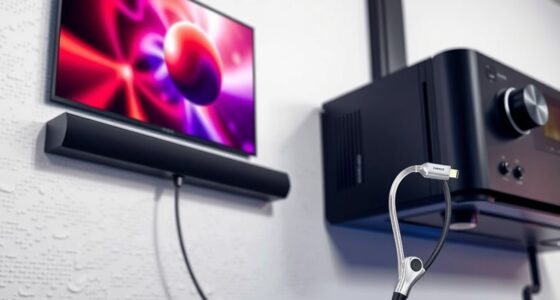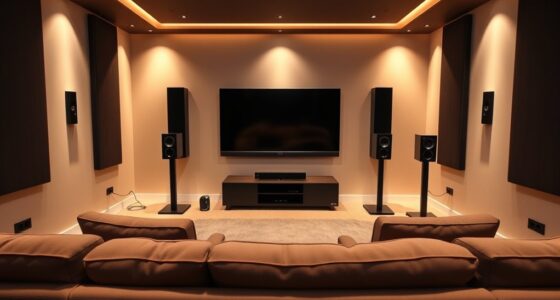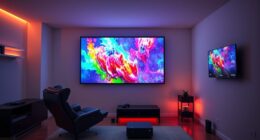In just 15 minutes, you’ll discover how EARC and ARC work to improve your home theater sound by transmitting high-quality audio signals from your TV to soundbars or receivers. You’ll learn common myths, like EARC being too complex or outdated, and understand that both technologies are practical and compatible with many devices. With quick tips on setup and troubleshooting, you’ll be able to optimize your audio experience fast—stay tuned to explore even more simple fixes and tips.
Key Takeaways
- EARC and ARC simplify audio connections; EARC supports higher-quality formats like Dolby Atmos, while ARC is suitable for basic surround sound.
- Myths: EARC is complex, but it’s designed to be straightforward; ARC is outdated, but it still works well for many setups.
- Proper calibration and high-quality HDMI cables are essential for optimal performance and avoiding audio issues with both technologies.
- Compatibility varies; ensure your TV and audio devices support EARC or ARC to utilize their full capabilities.
- Keeping firmware updated and properly configuring settings ensures seamless audio transmission and minimizes lag or distortion.
What Are EARC and ARC? Basic Definitions

Ever wondered what EARC and ARC actually are? These are technologies that enable audio signals to transmit between your devices. Specifically, they manage signal transmission through your HDMI cables, allowing audio to flow seamlessly from your TV to soundbars or receivers. EARC, or Enhanced Audio Return Channel, supports high-quality audio formats and better bandwidth, ensuring richer sound. ARC, or Audio Return Channel, simplifies connections by sending audio back to your sound system without extra cables. Both use advanced audio codecs to maintain sound quality, but EARC offers improved support for high-resolution audio formats. Understanding these basics helps clarify how your home entertainment system delivers audio, making setup easier and ensuring you get the best sound experience. Additionally, speaking 4 Me Online emphasizes that using professional voiceovers and soundscapes enhances clarity and listener engagement, which is essential for understanding complex audio technologies.
How Do EARC and ARC Improve Audio Quality?
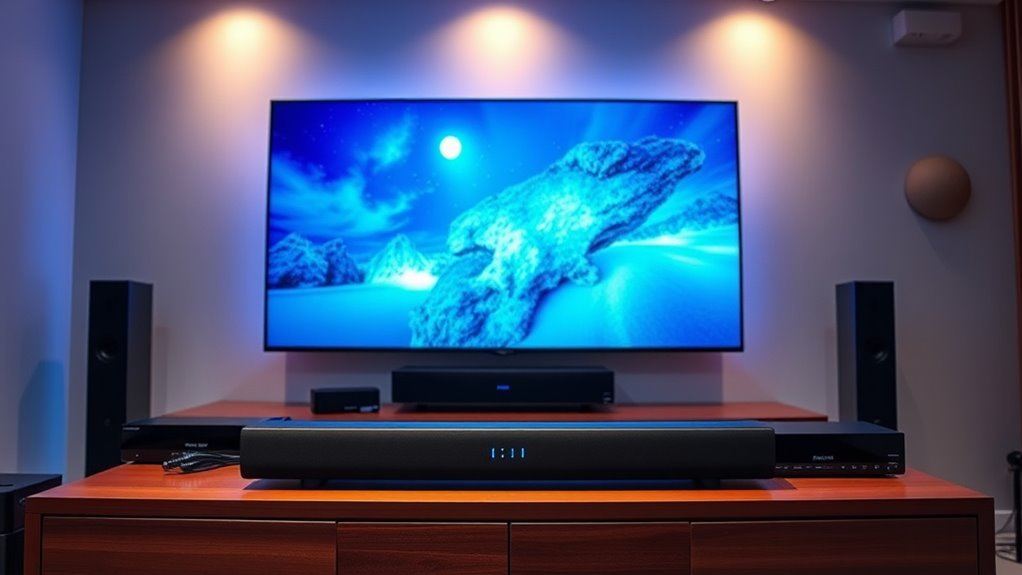
Both EARC and ARC considerably enhance audio quality by transmitting sound with greater clarity and detail. They support higher bandwidths, allowing more advanced audio codecs like Dolby Atmos and DTS:X to deliver immersive sound. This means you experience richer, more precise audio, whether watching movies or gaming. Proper sound calibration guarantees your devices are tailored for the best experience, minimizing audio lag or distortion. Additionally, the contrast ratio of a system can influence how well sound details are perceived in conjunction with high-quality audio signals, contributing to an overall immersive experience.
Compatibility: Do All Devices Support EARC and ARC?
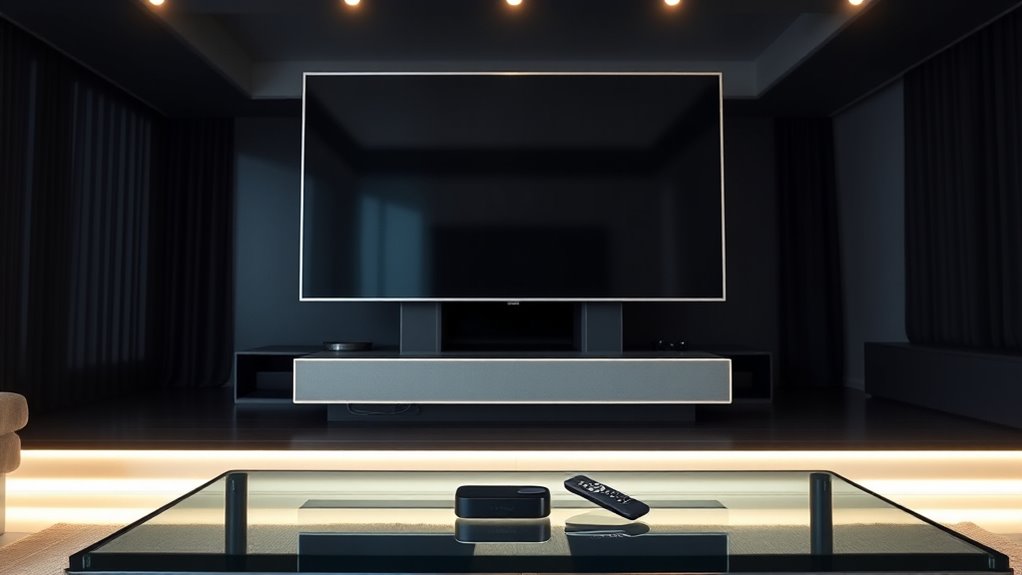
Are your devices compatible with EARC and ARC? Not all devices support these advanced audio features, so checking device compatibility is crucial. Older TVs and soundbars might only support ARC, or in some cases, neither. EARC requires specific hardware to handle higher bandwidth and codecs, which newer models typically include. Cable requirements also matter; HDMI cables must meet HDMI ARC or HDMI eARC standards—standard HDMI cables often won’t suffice. Look for HDMI cables labeled as “High-Speed” or “Ultra High-Speed” to ensure proper support. Before investing, verify your device specifications and compatibility details. While many recent models support EARC and ARC, older or budget devices might not. Confirming device compatibility and using the right cables helps you enjoy seamless audio without frustration. Additionally, understanding audio channel support can help you optimize your setup for the best sound experience.
Setting Up EARC and ARC: Quick Tips for Seamless Connection

Setting up EARC and ARC quickly and correctly guarantees you get the best audio experience without hassle. Start by choosing the right cable types—preferably high-speed HDMI cables that support eARC or ARC features. For superior sound, consider speaker placement; position your speakers to ensure clear audio flow and avoid obstructions. Connect your soundbar or AV receiver directly to your TV’s HDMI ARC or eARC port. Make sure your TV’s settings enable HDMI ARC/eARC and turn on CEC controls. Double-check that your device firmware is up-to-date to avoid compatibility issues. Additionally, understanding the 16PF personality traits can help in customizing your home theater setup for optimal user experience and comfort.
- Use high-quality HDMI cables rated for ARC or eARC
- Place speakers at ear level for better sound clarity
- Enable HDMI ARC/eARC and CEC in your TV settings for seamless control
Common Myths About EARC and ARC Debunked

Many people believe EARC is overly complicated, but it’s designed to be straightforward once you understand the basics. Others think ARC is outdated, yet it still offers reliable audio transmission for many setups. Let’s clear up these myths so you can make informed decisions about your home entertainment system.
Myth: EARC Is Complex
Despite common misconceptions, eARC (Enhanced Audio Return Channel) isn’t as complicated as it seems. Many believe it’s too technical to set up, but it’s designed to simplify high-quality audio transmission. With eARC, you get broader support for advanced audio codecs like Dolby TrueHD and DTS:X, reducing the need for multiple cables. It also minimizes signal latency, ensuring audio syncs perfectly with your visuals. The setup process is straightforward if your devices are compatible, and you don’t need to worry about complex configurations. Think of eARC as a future-proof upgrade that handles high-bandwidth audio easily. Understanding audio codecs can help you better appreciate the capabilities of eARC.
- It’s not just for tech experts; most modern TVs and soundbars support it.
- You don’t need to understand every detail about audio codecs to enjoy better sound.
- Its simplicity makes upgrading your home theater hassle-free.
Myth: ARC Is Outdated
Although some assume ARC is outdated, it remains an essential feature in modern home theater setups. ARC supports a variety of audio formats, including stereo, Dolby Digital, and compressed 5.1 surround sound, making it versatile for most content. While eARC offers higher bandwidth and uncompressed audio, ARC still handles many high-quality audio formats effectively. Proper speaker calibration guarantees you get the best sound experience, and ARC simplifies this process by transmitting audio signals reliably. This technology continues to be relevant because it integrates easily with existing devices and provides a straightforward connection method. Floating on Water is a common analogy for the seamless connection and flow of audio signals in ARC systems. So, despite newer options like eARC, ARC isn’t obsolete—it’s still a practical choice for many home theater enthusiasts seeking quality audio and simple setup.
Benefits of Using EARC and ARC in Your Home Theater
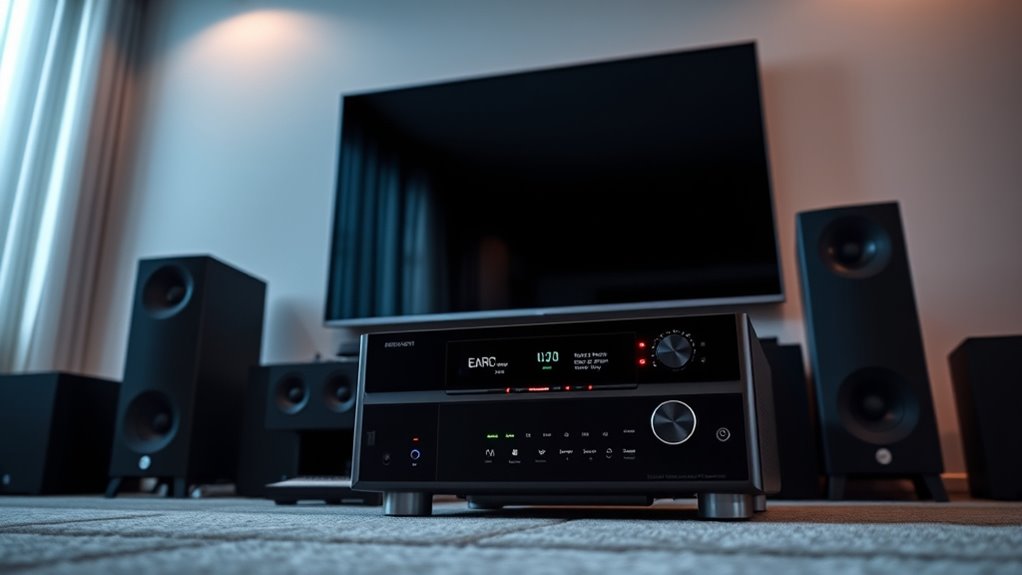
Using EARC and ARC in your home theater enhances your audio experience by delivering high-quality sound with minimal setup. These technologies simplify connecting your devices, reducing cable clutter and guaranteeing seamless audio transmission. They also support advanced audio formats, making your sound more immersive. When setting up, proper speaker positioning and accurate audio calibration become easier, helping you enjoy ideal sound clarity. Plus, EARC and ARC automatically sync with compatible devices, saving you from manual adjustments. This results in a more streamlined setup process and better overall audio performance. Additionally, understanding audio format support can help you maximize your system’s capabilities. Whether you’re watching movies or gaming, these features ensure crisp, clear sound that enhances your viewing experience. Overall, using EARC and ARC makes your home theater more efficient, immersive, and enjoyable.
Troubleshooting EARC and ARC: Simple Fixes
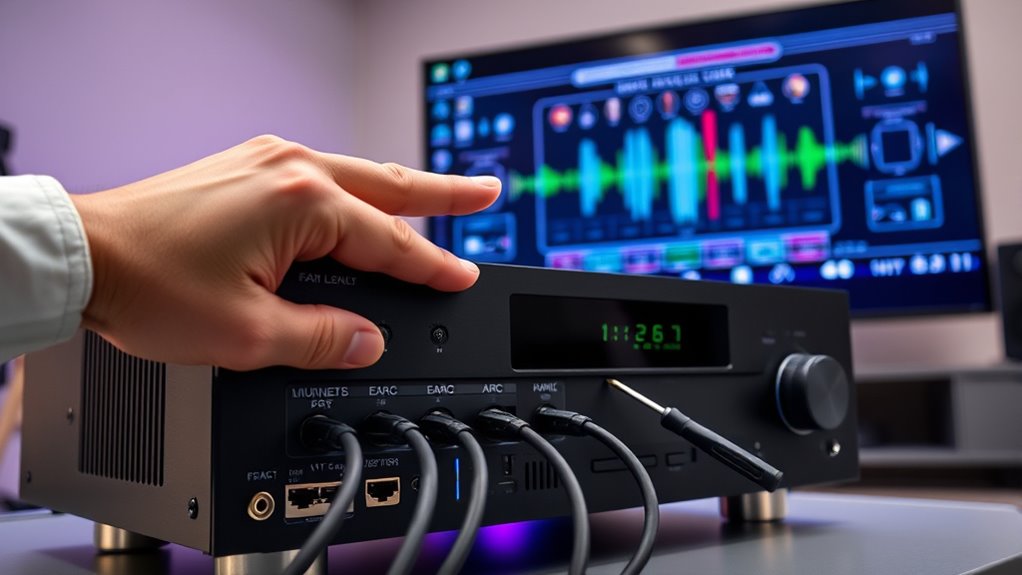
While EARC and ARC greatly improve your home theater experience, occasional issues can disrupt their performance. Common problems include audio dropouts or no sound. To fix these, start by checking your HDMI cables; a high-speed, HDMI 2.1 cable usually guarantees sufficient signal bandwidth. Also, verify your devices support the same audio codec; mismatched codecs can cause compatibility issues. Restart your TV and sound system to reset connections. Adjust your audio settings to ensure ARC or EARC is enabled and set to the correct input. Here’s a quick reference:
| Issue | Fix |
|---|---|
| No audio or dropouts | Use high-speed HDMI cable, check audio codec support |
| Signal bandwidth problems | Reduce audio format complexity or upgrade cables |
| Compatibility issues | Update device firmware |
| No sound after setup | Restart devices and re-enable ARC/EARC settings |
Additionally, ensuring your devices support the latest audio formats can help prevent future issues.
Quick Wins to Maximize Your Audio Experience Today

To get the most out of your audio setup today, start by understanding how EARC and ARC work together to deliver better sound. Next, make sure your devices are correctly configured for peak performance, and don’t forget to check for and fix common issues. These quick steps will instantly enhance your listening experience. Additionally, staying informed about latest audio technology trends can help you optimize your system further.
Understanding Earc and ARC
Understanding Earc and ARC is key to opening better audio quality from your home entertainment system. These technologies transmit audio signals between your TV and audio devices, enhancing clarity and reducing lag. To get the most out of Earc and ARC, pay attention to your device compatibility and supported audio formats, as not all equipment handles these features equally. Additionally, reviewing personal finance management principles can help you budget for upgrades like high-quality HDMI cables or new audio devices to ensure optimal performance.
Getting familiar with these basics helps you unlock superior sound without complicated setups.
Setting Up for Success
Achieving ideal audio quality starts with quick, easy setup steps you can do today. Begin by focusing on speaker placement; position your speakers at ear level and equidistant from your seating area to create a balanced soundstage. Proper speaker placement reduces audio distortion and enhances clarity. Next, perform simple audio calibration—use your TV or receiver’s setup microphone or manual adjustments to optimize sound levels. This step ensures your system correctly interprets audio signals and maximizes the benefits of eARC and ARC. Taking these initial steps helps prevent common issues and sets a strong foundation for better sound. With well-placed speakers and calibrated audio, you’re ready to enjoy a richer, more immersive listening experience right away.
Troubleshooting Common Issues
Even with proper setup, you might still encounter issues like no sound, audio dropouts, or unbalanced volume levels. These problems often stem from audio latency or misaligned soundbar calibration. To troubleshoot, start by checking your connections and ensuring your devices are updated. If audio latency causes delays, try adjusting your soundbar’s settings or enabling low-latency mode if available. For unbalanced volume, recalibrate your soundbar to match your TV’s output, ensuring consistent sound levels. Also, verify that your HDMI or ARC/eARC connections are secure and compatible. Sometimes, a simple restart of your devices can resolve temporary glitches. Keep these steps in mind to quickly address common issues and enjoy a seamless, immersive audio experience.
Frequently Asked Questions
Can EARC and ARC Be Used Simultaneously With Different Devices?
Yes, you can use eARC and ARC simultaneously with different devices in a multi-device setup, but it may cause issues with audio synchronization. Your TV might struggle to manage multiple audio signals, leading to delays or audio cutouts. To guarantee smooth performance, it’s best to connect each device carefully and check compatibility. This way, you can enjoy ideal audio quality without sacrificing synchronization across your devices.
How Does EARC Differ From ARC in Terms of Bandwidth?
You’ll notice that eARC offers much higher HDMI bandwidth compared to ARC, which allows for better audio quality. While ARC’s bandwidth limits the types of audio it can transmit, eARC supports uncompressed formats like Dolby TrueHD and DTS-HD Master Audio, delivering richer sound. This means, with eARC, you get more detailed, immersive audio, making it ideal for high-end sound systems. So, the main difference lies in their HDMI bandwidth capabilities affecting audio quality.
Are There Any Security Concerns With Using EARC and ARC?
While eARC and ARC enhance your audio experience with high-quality sound, they do pose some security concerns. You might worry about privacy concerns and hacking risks, especially if your devices aren’t updated regularly. Hackers could potentially exploit vulnerabilities in the HDMI connection or firmware, risking unauthorized access. To stay safe, keep your devices updated, use strong passwords, and disable features when not in use to minimize security threats.
What Is the Future of EARC and ARC Technology?
The future of eARC and ARC technology looks promising, especially as wireless connectivity improves and supports higher bandwidths. You’ll see more seamless integration with advanced audio formats like Dolby Atmos and DTS:X, enhancing your home theater experience. As manufacturers adopt these standards, expect better compatibility, higher quality sound, and fewer setup issues. This evolution will make your audio systems more intuitive and capable of delivering richer, more immersive sound.
Do Older TVS Support EARC or ARC Without Upgrades?
Ever wonder if your older TV can support eARC or ARC? Generally, most older models don’t support eARC or ARC without upgrades. TV compatibility depends on hardware and firmware updates; some may get limited support through firmware. However, if your TV lacks the necessary ports or hardware, upgrading might be the only solution. Check your TV’s specifications and firmware updates to see what’s possible before investing in new equipment.
Conclusion
Think of EARC and ARC as the bridge to your perfect home theater. When you connect them seamlessly, you unlock a world of clear, immersive sound—like opening a window to a richer experience. Don’t let myths block your view; embrace the facts and troubleshoot confidently. With a little effort, you’ll transform your space into an audio sanctuary, where every sound is a guiding star leading you to pure entertainment bliss.

